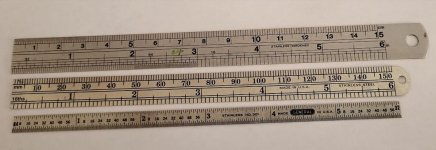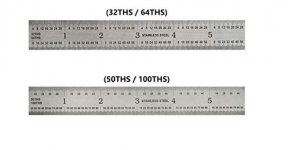You are using an out of date browser. It may not display this or other websites correctly.
You should upgrade or use an alternative browser.
You should upgrade or use an alternative browser.
Any steel rules with graduations in 128ths?
- Thread starter ChuckS
- Start date
kevinculle
Member
I have never seen Imperial graduations finer than 1/64". I have an Incra 12" T-rule with 1/64" graduations at the bottom, and they are useable but I can't imagine reading 1/128" lines.
Cheese
Member
ChuckS said:The finest graduations I have on a steel rule are in 64ths:
[attachimg=1]
Do steel rules with graduations in 128ths exist?
Starrett has several rules that are in 100ths of an inch. It's a pretty handy item now & then. The increments are just incredibly small to see and 128ths would be even worse.
rvieceli
Member
[member=57948]ChuckS[/member] i believe you’re going to have to read between the lines on your 64th gradations.
Machinist rules come in 1/10 and 1/100 gradations
Aircraft style in 1/50 and 1/100
But can’t imagine accurately reading 1/128
Ron
Machinist rules come in 1/10 and 1/100 gradations
Aircraft style in 1/50 and 1/100
But can’t imagine accurately reading 1/128
Ron
There sure wouldn't be much space between the lines. 1/128" is a little less than .008" I believe our laser graduation lines are about .004". That would leave less than .004" between lines and I'm not sure how many people could actually resolve that (without super-cheaters). If I'm looking for anything finer than 1/64th, I'm using calipers. Actually, that's a lie. If I'm looking for anything finer than 1/32nd, I'm probably using calipers.
Packard
Member
I would have to say that a ruler is the wrong measuring instrument for that level of precision.
You are probably in the territory of a vernier caliper. Our QC Department had a 24” vernier (old style vernier, no dial, no digital readout). Even so, about $900.00.
But if you need that accuracy, you need the appropriate measuring instrument.
Note: I cannot think of any woodworking requirement for that level of accuracy.
https://www.tequipment.net/Mitutoyo...MI47HZvvrZ_gIV7yqzAB1A5QdZEAQYBCABEgKHlfD_BwE
You are probably in the territory of a vernier caliper. Our QC Department had a 24” vernier (old style vernier, no dial, no digital readout). Even so, about $900.00.
But if you need that accuracy, you need the appropriate measuring instrument.
Note: I cannot think of any woodworking requirement for that level of accuracy.
https://www.tequipment.net/Mitutoyo...MI47HZvvrZ_gIV7yqzAB1A5QdZEAQYBCABEgKHlfD_BwE
gunnyr
Member
If you have a rule with 1/64ths then you can read it to 1/128ths. Your eye can accurately pick out the middle. If that is not sufficient then I am in agreement with the others that calipers are the way to go.
Cheese said:ChuckS said:The finest graduations I have on a steel rule are in 64ths:
[attachimg=1]
Do steel rules with graduations in 128ths exist?
Starrett has several rules that are in 100ths of an inch. It's a pretty handy item now & then. The increments are just incredibly small to see and 128ths would be even worse.
100ths? It prompted me to look for a sample to see how it'd look like, and one of the results led me to a pdf at the littemachineshop site:https://www.google.com/url?sa=t&rct...eelrules.pdf&usg=AOvVaw0-qxuH5ORJ_LB3Fyix1dwM
Packard
Member
I would note that large calipers do not use dials or digital readouts. Too much chance for accumulated error.
Instead they use a “vernier” scale (also called a “nonius” scale). That was the kind I was taught to use. It is easy enough to master.
The video is better than anything I could explain. It is based on the idea that humans are able to align things with great precision by eye.
The problem with those tight measurements is that they require tightening the calipers to the same tightness repeatedly. With soft woods, you run the risk of compressing the wood, rather than taking the measurement.
Micrometers attempted to increase repeatability by adding a knob at the end with a precision clutch that would repeat the pressure. But that is on metals. On pine or poplar, they would not be accurate.
Instead they use a “vernier” scale (also called a “nonius” scale). That was the kind I was taught to use. It is easy enough to master.
The video is better than anything I could explain. It is based on the idea that humans are able to align things with great precision by eye.
The problem with those tight measurements is that they require tightening the calipers to the same tightness repeatedly. With soft woods, you run the risk of compressing the wood, rather than taking the measurement.
Micrometers attempted to increase repeatability by adding a knob at the end with a precision clutch that would repeat the pressure. But that is on metals. On pine or poplar, they would not be accurate.
Packard
Member
Vtshopdog said:Speaking of Vernier scales, anybody else here old enough to remember using a slide rule in math class somewhere way back in a previous century?
I bought my sister a Post slide rule. It used a genuine black widow spider’s web filament for the crosshair. I recall that it cost me about $70.00 back in 1966. That is about $660.00 in current dollars. She used it until the mid 1970s when she bought the first Texas Instrument scientific calculator.
In the mid 1970s, my brother-in-law wrote a book on how to use a slide ruler and it was accepted for publication. But the day TI announced their calculator, the publisher backed out of the agreement.
I believe I still have my 12” and 6” Pickett slide rulers. The 12” in high visibility yellow.
My old Machinery Handbook had trig and log tables. Newer editions dropped both.
It’s probably like riding a bike and put one in my hands and I could use it. But thinking now, I can’t remember how.
kevinculle
Member
I used a slipstick all through college (early '70s) and in my early years as an engineer. Once you become proficient you can work fast and precisely...no 10 significant figures but good enough for serious work. I still have mine down in the shop and every once in a while, I will take it out to see if I still can work it...so far, so good.
Packard
Member
kevinculle said:I used a slipstick all through college (early '70s) and in my early years as an engineer. Once you become proficient you can work fast and precisely...no 10 significant figures but good enough for serious work. I still have mine down in the shop and every once in a while, I will take it out to see if I still can work it...so far, so good.
My sister was a research biologist (well-known in her narrowly defined field). She used the slide rule to prove to her satisfaction that her premise was correct. But for the research papers she needed exact numbers, which the slide rule does not provide. So the need for log and trig tables.
Steve1
Member
1/128th inch lines ??? (=.0078")
You have far better eyesight than I do.
You have far better eyesight than I do.
Mini Me said:It would be possible to do using an Incra style rule where the divisions are set out vertically but the drawn line would most probably be that wide anyway which defeats the whole idea.
This^
A .5mm lead is .020".
And if you're good enough to line up a marking knife on a scale to 1/128", I tip my cap.
peacefulandpatriotically
Member
- Joined
- Jan 6, 2023
- Messages
- 76
ChuckS said:The finest graduations I have on a steel rule are in 64ths:
[attachimg=1]
Do steel rules with graduations in 128ths exist?
what is your intended use case for a ruler with 1/128" of an inch graduations?
Similar threads
- Replies
- 3
- Views
- 672
- Replies
- 13
- Views
- 363



